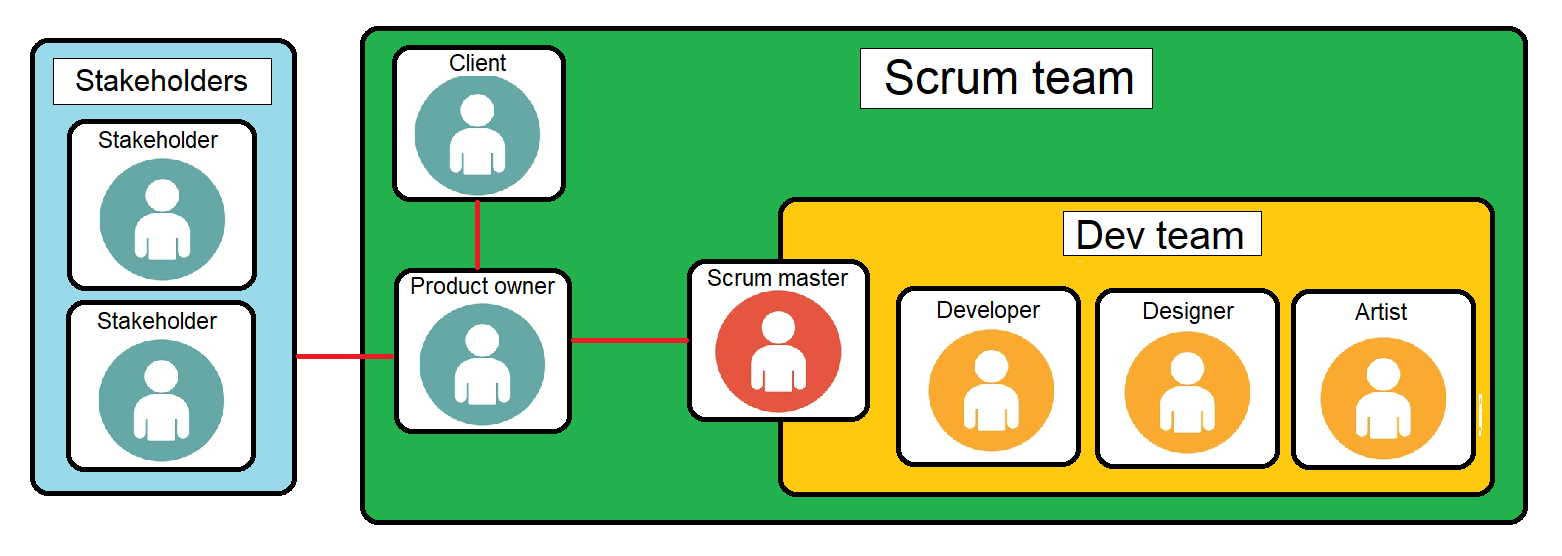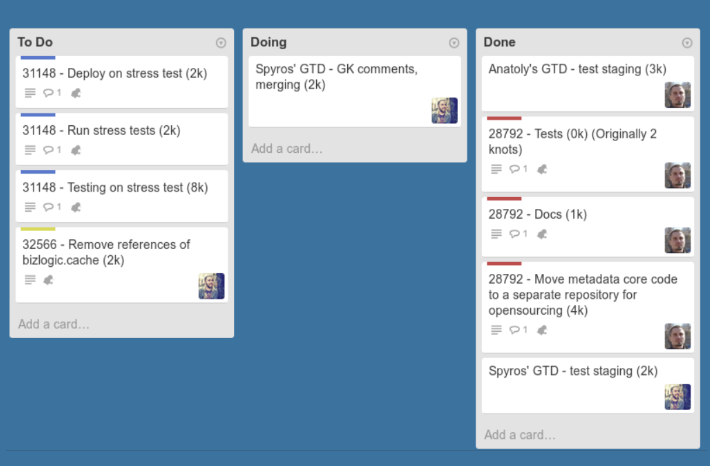Project management 4. Scrum
Project management 4. Scrum
What is Scrum?
- Scrum is a framework for delivering products (usually software)
- Designed for teams of ten or fewer members
- Scrum Values
- Minimal chance of failure: product is worked on in small increments
- Transparency: changes are visible to the team
- Work is split to Sprints: goals that can be completed within time-constrained iterations
- Sprints are most commonly two weeks long (for us, shorter)
- Progress is tracked and re-planned in Dailies, 15-minute time-boxed meetings
Why Scrum for game development?
- Through its practices and principles, Scrum creates conditions to achieve good results
- Scrum gives agency to team members: meeting the goal is a team effort
- Scrum creates transparency: problems get addressed early
- Scrum isn’t magic: you need to continuously enforce its practices in action
- Scrum facilitates communication, but doesn’t solve any problems for you!
- Cross-discipline teams: Enables teams to deliver features and mechanics that have clear value
- Self-management: Enables teams to select the amount of work they can commit to every sprint and complete that work through whatever means they find appropriate
- Self-organization: Enables teams to have a degree of authority and responsibility to select their membership
Scrum basics
Scrum people

Dev team
- Small team that aims to deliver a product
- Organizes itself and its work
- Collaborates with Product owner
- Creates product increments in a series of sprints
Scrum master
- Helps to facilitate usage of Scrum to the team
- Ensures the Scrum framework is followed
- Aims to improve team’s workflow
- Basically an acting producer!
- Can be a part of the dev team (a “peer leader”)
- …but should not be the product owner
- Can be a different person every Sprint
Product owner
- Accountable for profit & loss
- Listens to the client’s wishes
- Manages the Product Backlog
- Representation of stakeholders and clients to the Dev Team
- Chooses what to release - and when
The rest
- Stakeholders (not actually part of the team)
- People outside the Scrum team who have an interest in the product
- Sales, marketing, end customers, etc
- Client
- Monitors product backlog
- Is responsible for the upkeep of the product backlog
Backlogs
Product backlog
- Holds the requirements for the product
- Managed by the Product Owner
- Composed of tasks
- unit of deliverable work
- well-defined completeness
- completable during a single Sprint
- Features, Bugfixes, Content…

Sprint backlog
- A list of tasks to be completed during the Sprint
- Selected from the Product backlog
- A forecast of what is aimed to be done during the Sprint, not a promise!!!

Definition of Done
- When is a task considered done?
- This is decided by the Dev team in Sprint Retrospective (“Retro”)
- Can change as project progresses
* “It works” -> “It passes tests”
Sprint Events
- First day: Sprint Planning
- Every day: Daily Scrum
- Last day: Sprint Review & Sprint Retrospective
Sprint planning
- Starts a new Sprint
- The whole Scrum team attends
- inspects the whole Product Backlog
- A Sprint Goal is created and dissected into a new Sprint Backlog
- The Sprint Goal is immutable
- The exact implementations are not discussed
- those are rather left for the Dev Team to decide
- New tasks are given to the Dev Team
Daily Scrum (“Daily”)
- Only Dev Team attends, with these goals:
- Inspect the progression towards the Sprint Goal
- Inspect how the Sprint Backlog is clearing out
- Create a plan for the next 24 hours
- Max. 15 min long!
- Keeps everyone on the same page
- $\Rightarrow$ Optimizes collaboration and performance of the Dev Team
- Example topics to address in a Daily:
- What have you achieved since the last Daily?
- What problems have you faced?
- How does the team address problems?
- Is there need for (re)allocation of tasks?
Sprint review
- Attended by the Scrum team and stakeholders
- Goal: Offer feedback and open up discussions about the Sprint
- Starts off with a feature demonstration
- Product Owner presents the state of the Product Backlog
- Dev Team tells what happened during the Sprint
- How different problems were addressed?
- What was their effect?
- Everybody provides and listens for feedback
Sprint retrospective (“Retro”)
- After every Sprint Review
- Only the Scrum team attends
- worries and thoughts are brought up
- Possible discussion topics
- What went right?
- What should be improved?
- Tools needed and used?
- The suitability of the Scrum process.
- What does Done mean, and should it be redefined?
Scrum master tasks
- Continuously:
- Make sure the task board on GitHub is up to date.
- Make sure everyone is able to attend the dailies.
- Make sure everyone is heard and contributes at dailies.
- If someone needs help, you help them find assistance or assist them yourself.
- Before the dev meeting:
- Make sure the task board on GitHub is up to date.
- Make sure someone is ready to present the newest working version of the program, with all the new changes pushed
- Write down the state of tasks listed in the Sprint backlog
- Discuss what problems were encountered during the last Sprint, and how were they addressed.
Why Scrum isn’t perfect for gamedev
- Gamedev is messy!
- Following a rigid structure can limit the team’s output
- Burndown charts detached from reality
- Agile was developed mostly for teams where engineers are interchangeable
- Game dev is just too fragmented for that
- Long pre-production phase of creative exploration
- …that usually bleeds into production…
- $\Rightarrow$ a mess that resists planning
- In gamedev, you don’t have a customer you can talk with
- Even if you have a customer, they don’t know what they want
- …because the game hasn’t been made yet!
- Do ask your users regularly if the game is fun, though
Aki Kanerva: The ideas of Scrum that work for gamedev
- Facilitate everyone staying up to date
- Visualize progress
- Break features down into tasks, and tasks into subtasks
- Keep a backlog
- Remember that plans are not set in stone and also need iteration
- Check often if people are stuck
- Estimate work
- Stop often to evaluate the amount of meta work, including work estimates
- Encourage people learning beyond their own discipline
- Extra: Encourage ownership of features, not discipline (Not part of Scrum!)


